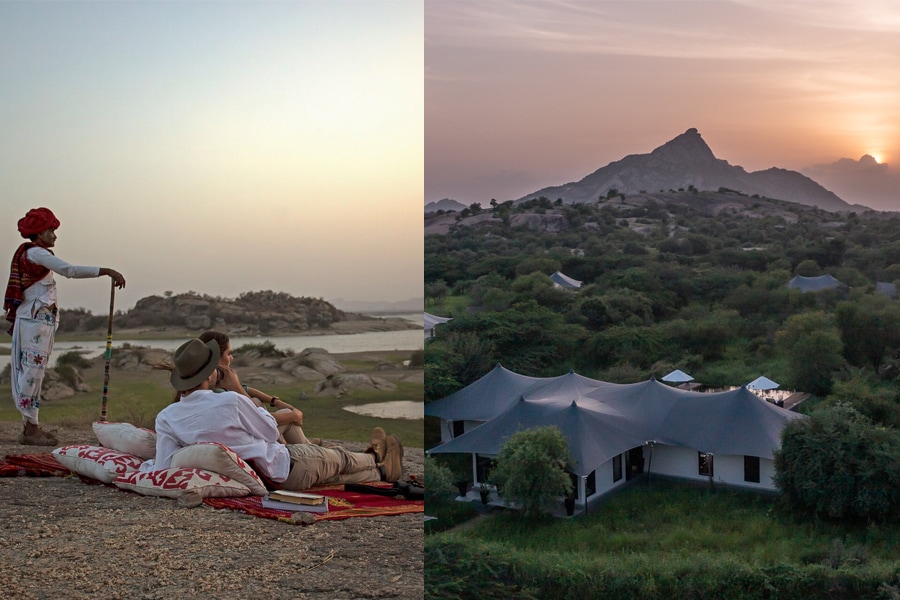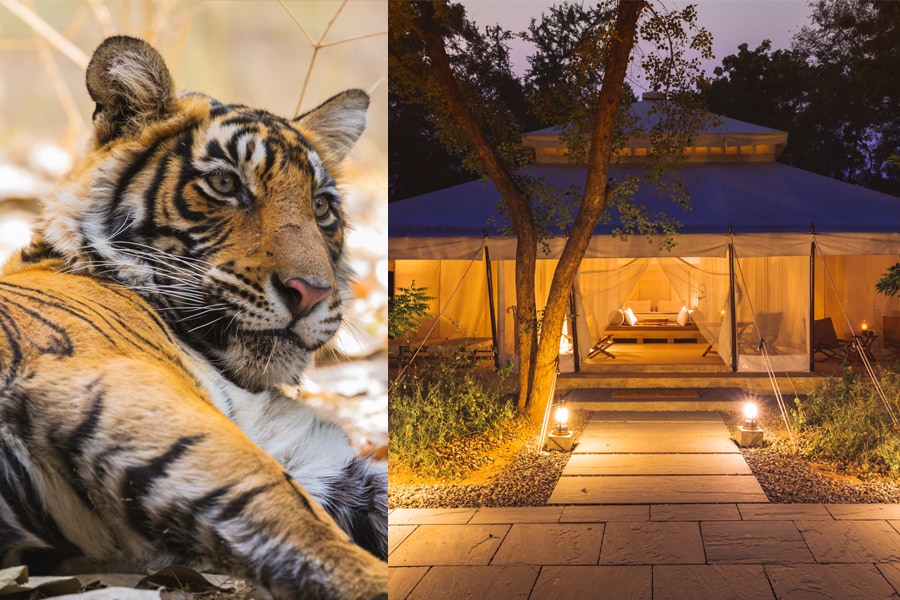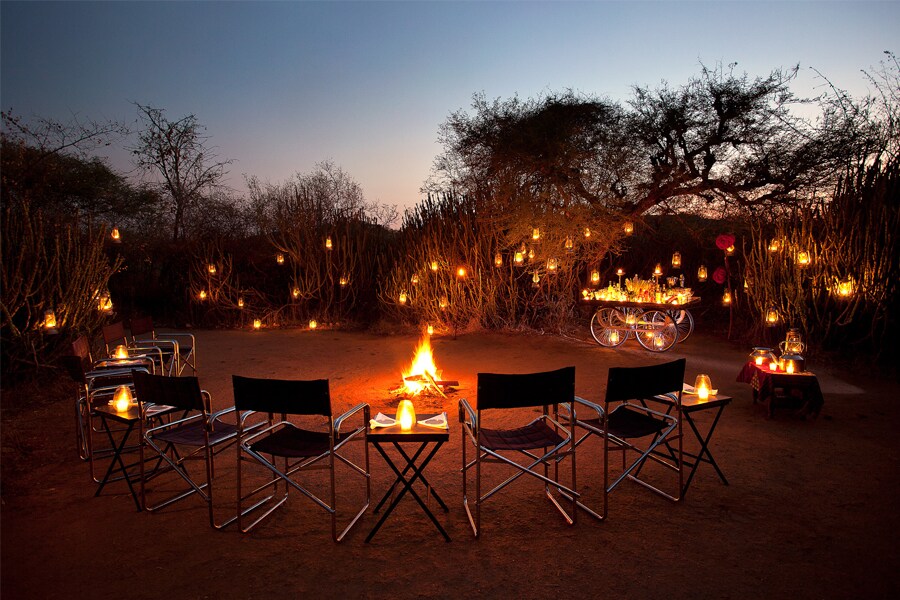Glamping the great outdoors in uber luxury
Spas, jacuzzis, private chefs and butlers are all part of the glamping experience and living it up in the wild. And post-Covid, the travel segment is only set to grow


Picture this: A night out in the wilderness of India enjoying a freshly prepared bush dinner as the sounds of the forest come alive–-birds returning to their nests and frogs croaking in the distance. After you have sipped your post-dinner drink you move to a camping tent—complete with a comfortable bed, jacuzzi, private bathtub and outdoor area, all designed to provide an ultra-luxurious experience in the midst of nature. This is the definition of glamping - glamour camping.
Interest in glamping rose among domestic travellers during the pandemic when many were in search of alternative ways to satisfy their travel bug as international exploration was on a temporary but long pause.
Now, this travel segment is expected to grow as the desire to explore more open spaces gains momentum and the offerings made by glamping sites get more enticing. Here is a peak into the world of glamping in India.
 Gazing at the Jawai landscape at dusk and Jawai Eden at dusk.
Gazing at the Jawai landscape at dusk and Jawai Eden at dusk.
Many properties offering luxury tented accommodation have seen a shift in perspective in recent times in the way people want to enjoy their holidays--from wanting to immerse themselves in natural environments to exploring wildlife areas.
“We have seen an incredible rise in numbers over the last five years and this is primarily due to Covid," says Shaaz Jung, managing director of The Bison Resort, a luxury ecotourism resort situated on the banks of the Kabini backwaters at the confluence of the Bandipur and Nagarhole National Parks, Karnataka. “Post-Covid we"ve had the highest occupancy rates ever," he adds.
Initially, The Bison Resort was heavily reliant on international tourism. However, in the last five years, domestic tourism has skyrocketed. “Ninety percent of our traffic now is domestic and only 10 percent is international," says Jung. “The last five years The Bison Resort has seen some of our highest occupancy rates, between 85 percent to 95 percent through the year."
Also read: Also read: Mapping culinary tourism in Europe through summer"s restaurant bookings
The domestic market also grew due to the pandemic for SUJàN, a family-owned and managed group of three camps with just 45 rooms in Rajasthan. “We are delighted that 50 percent of our guests are now Indians with the remaining 50 percent international," says Laura McGowan, global brand director, SUJàN.
 SUJàN, Jawai guided safari walks and spotting a leopard.
SUJàN, Jawai guided safari walks and spotting a leopard.
Stepping into the wild to discover the wonder of India’s national parks is alluring. However, it’s the thoughtfully curated activities and an out-of-the-box creative atmosphere designed by glamping sites that help their guests connect and immerse themselves in the natural surroundings.
For Jung, Kabini is the real Jungle Book. “It"s got incredible diversity of Asiatic wildlife," he says.
His resort has created various opportunities to catch glimpses of these incredible sights. The African-style tents overlook the forest so guests can come across a local in action straight from their room.
They also have the option of leaving their luxury tent to have a real camping experience in a small dome tent on the property in a wooded area close to the backwaters, which includes food cooked by a private chef.
One can also get up close to see black panthers, tigers and leopards on safaris or take a boat ride to explore the backwaters and the local colour.
Up north lies tented camp Aman-i-Khà¡s in the Aravalli Hills on the fringes of Rajasthan’s Ranthambore National Park--an important domain for the Bengal Tiger.
Tiger sightings and surprise nocturnal visits are part of the thrill. But Aman-i-Khà¡s also curates experiences that make for memorable moments in the forest--dinner under the stars with the moon as the only source of light, fireplace storytelling and surprise breakfast locations such as the guava orchard, breakfast in the bush, and camel safaris.
To celebrate 50 years of India"s Project Tiger and 20 years of Aman-i-Khà¡s this year, guests can experience the national park with wildlife conservationist Daulat Singh, who has spent 33 years with the Rajasthan Forest Department working with threatened and endangered species including Bengal Tigers and leopards.
 A lounging tiger at Ranthambore National Park Safari and Aman-i-Khà¡s Tent Interiors.
A lounging tiger at Ranthambore National Park Safari and Aman-i-Khà¡s Tent Interiors.
You may be out in the wild, but if you are glamping, there is no room for roughing it out. A luxury wilderness tended experience would not be complete without the highest level of quality and comfort as people get closer to the natural world.
Each of Aman-i-Khà¡s’ 10 soaring guest tents, which starts from Rs 119,958.50 ($1,450) per night, features classic and decorative furnishings--king-size bed, large daybed, stone soaking tub–-with the sleeping and bathing spaces divided by white cotton drapes Mughal-style. A personal butler is also assigned to each tent. “In between daily jeep safaris to catch a glimpse of tigers and other wildlife, guests can enjoy rejuvenating spa treatments or a dip in the traditional step-well pool, before drinks around a communal firepit and dinners lit by flickering candles under a canopy of stars," says Harry Fernandes, country manager-Aman, India-Aman-i-Khà¡s (a unit of Guardian International Private Limited).
Also read: In Istanbul"s private retreats of the Sultans, time stands still
At SUJàN, rates start from Rs 59, 000 to Rs 3, 69,000 per night for up to two guests depending on the type of suite and season. “We have designed all three camps in-house, each experience from the culinary to the cultural, from the fabrics to the food, allowing us to connect our guests, uncontrived, to the very soul of our natural and cultural heritage, whilst savouring our inimitable art de vivre," says McGowan.
 Desert folk musicians perform at SUJàN The Serai Jaisalmer and plated dessert.
Desert folk musicians perform at SUJàN The Serai Jaisalmer and plated dessert.
Having a positive impact through wildlife conservation, sustainable initiatives and local employment to protect and nurture the wilderness is given just as much importance as providing guests with world-class accommodation and memorable experiences.
The Bison Resort, whose ethos is to give back to the area, uses alternate sources of energy. Their temporary structures are built with wood and use very little concrete and RCC. "So our carbon footprint is very low," says Jung.
The lodge also employs 95 percent people from the local area. “So the service we offer is incredibly indigenous and in support of the local people," says Jung.
Aman-i-Khà¡s camp has implemented several initiatives to reduce its impact on the environment, including using solar energy, growing the majority of the ingredients used in its kitchens on its own organic farm on the property, rainwater harvesting, and recycling. “Additionally, the team is trained in sustainable practices, and the camp works with local communities to promote sustainability as a way of life," says Fernandes.
 Ranthambore Fort and Aman-i-Khà¡s Ranthambore Tent Interior.
Ranthambore Fort and Aman-i-Khà¡s Ranthambore Tent Interior.
While the world of glamping has a lot to offer haunters of the woods seeking extraordinary experiences there is much more to explore.
The golden days of glamping are still ahead, according to Pankaj Dhingra, managing director, Jumpking International LLP, parent company to Bengaluru-based company CampKing that provides glamping tents and glamping consultation.
“Developing a glamping resort with multiple suppliers, options, and research takes a long time, generates problems and costs money," says Dhingra, whose companies have been involved in over 1700 projects setting up glamping sites and adventure set-ups in India and abroad.
The Oberoi and Breath Resorts and Villas are among the Indian companies CampKing has helped launch glamping sites for.
Also read: What will 2023 bring for travel & hospitality
“We get customer requests and enquiries from more than 5 lakh customers per year out of which 2500+ clients visit our experience centre from all over the world," he adds.
At the CampKing experience centre in Bengaluru is a showroom that displays glamping products, which include a range of tents in various shapes, like the Mushroom tent, also known as the dome tent that elevates the natural landscape with its big bright window and the Studio style tent, which is an improved version of a safari tent. These tents cost upwards of Rs 3,80,000.
Dhingra believes that India’s glamping market will bloom in the next five years. “We believe that people are looking for unique experiences in nature where they can reconnect with their lives and the environment," he says.
 SUJàN, Jawai fireplace at dusk
SUJàN, Jawai fireplace at dusk
Glamping is a great opportunity to highlight the importance of conservation and preservation to ensure that our ecosystems remain healthy and balanced.
“We need to be more conscious of the impact our actions have on the environment and strive for ways to reduce it," says Fernandes. “This can include activities such as reducing waste production, promoting renewable energy sources, and investing in green infrastructure."
“It is important to ensure that our sustainability initiatives are aligned with modern technology and traditional ayurveda," says Fernandes. "By combining the best of both worlds, we can create a natural and wellness-centered approach to our sustainability efforts," Fernandes adds.
SUJàN believes in making a difference and a measurable positive impact through tourism that can raise awareness about the need to nurture nature and contribute to conservation and community development projects in the area. “We have always believed that the right kind of tourism can actually save India’s endangered wildlife and habitats, promote and preserve our rich cultural heritage and provide livelihood to our local communities," says McGowan.
First Published: Feb 25, 2023, 12:14
Subscribe Now